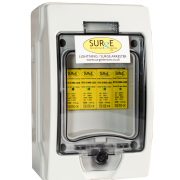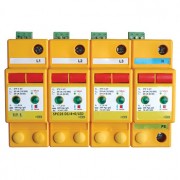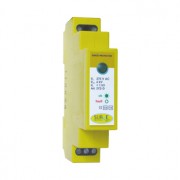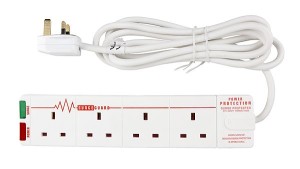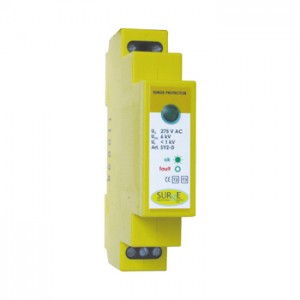Fitting our Surge Devices into traditional manufacturers mains units
This is a question that will crop up quite a lot this year, especially as Surge Protection gains popularity through the 18th edition of the wiring regulations. We have been asked time and time again over the years about whether contractors are allowed to install our Surge Protection Device into a traditional manufacturers mains unit. We hope this short blog article will clear things up for you.
Most consumer unit manufacturers, quite rightly, won’t guarantee their boards if another manufacturers MCB’s or RCBO’s are fitted inside it. This is generally because the MCB’s are specifically designed to align with their own unique busbar systems and a badly fitting MCB might create a hot spot with a poorly aligned busbar connection.
However, a free standing din-rail mounted device, such as a surge arrester or timer etc. is not connected to the busbar system, it is only wired by the installer with cables, therefore such problems can’t exist.
If the consumer unit manufacturer insists you use their own surge arrerster, this is purely for commercial reasons, as the installer you can decide to fit our surge arrester in any manufacturers board and we will guarantee it for 10 years. Or you can fit our surge arrester in a separate enclosure directly adjacent to the consumer unit. Even with the separate enclosure added, our prices will still be well below the cost of a surge arrester from the traditional manufacturers.
If you would like any more info on this matter please call our dedicated team on 01484 851 747.
Lightning Protection – Product Focus – 10651/LED
Last week we discussed lightning protection being mandatory if the building is fed by over-head lines or it has external lightning protection. To follow on from that, in this week’s blog we will be talking about a specific device, the 10651/LED.
Why It’s Installed:
For those that missed our last blog, here’s a quick re-cap on why Lightning protection is installed.
When lightning hits external lightning protection (or over-head power lines) the lighting travels down the cable to the main incomer of a building. Although external lightning protection is earthed, only 50% of the total voltage from a lightning strike will go to earth and the other 50% (possibly up to 100Ka) will travel across the cross-bond on to the incoming panel and out on to the electrical circuits in the installation. This creates a massive risk to the property and to any life inside.
What Is It:
The 10651/LED is a three-phase lightning and surge combined device. This means that it not only protects against lightning strikes, it will also take any surges out of the electrical system. The 10651/LED is a large device (about 8 module width), which contains all the necessary components to ensure that the electrical system is safe from over-voltages and lightning strikes.
How It Works:
As we discussed last week, the lightning will travel down the copper tape (or over-head cable) and on to your distribution board. With the 10651/LED being so big, it is usually mounted in to an enclosure next to the main panel. When the device detects the spike in the system (whether Lightning or a surge), it directs the spike down to earth and re-sets itself. This device works in about 25ms, which is much faster that the RCD will detect anything, meaning that the breakers wont trip and the electrical supply will continue un-interrupted.
How It’s Installed:
As I previously mentioned, the 10651/LED is very large and usually is mounted in an enclosure next to the board, this needs to fit as close to the main switch as possible. From an existing three-phase breaker in the board, take your live cables in to the top of the device. Take a neutral cable from your neutral bar to the neutral terminal on the top of the device. Finally take an earth connection from the earth bar to the bottom of the device, for this connection the cable needs to be less than 50cm in length.
If you need any advise about which device you need, please use the contact form or call us in the office on 01484 581747.
Lightning & Surge Protection; What is Mandatory?
It’s all very confusing when it comes to trying to work out what’s mandatory and what’s a recommendation when it comes to lightning & surge protection. This week in our fortnightly blog we decided to try and make it all a bit clearer for you.
What is mandatory?
Lightning Protection
Lightning protection is mandatory in certain circumstances;
- If the building has external lightning protection already installed (copper tape and earth rods)
- If the building is fed by overhead power lines
Why?
- When external lightning protection is fitted: When lightning hits the external protection it travels down the copper tape to where it will be cross bonded to your incoming panel, where it connects with the earth. The reason for the mandatory requirement of lighting protection, is that only 50% of the lighting impulse will go directly to earth, the other 50% will travel through the cross bond on to the incoming panel and out on to the electrical circuits in the installation. This creates a massive risk to the life and to the property in this installation.
- When the building is fed by overhead power lines: When lighting hits the power line, we have the same problem as with the external lightning protection. The lightning impulse will travel down the power line directly on to the incoming panel, where again it will travel out on to the electrical circuits in the installation.
It is more common to see church’s, schools and hospitals with external lightning protection fitted, as these are classed as high risk buildings, especially with them being public places and in most instances tall. It is less common to see domestic dwellings with external lightning protection, however it does happen occasionally. It is more common to see a domestic dwelling with overhead power lines feeding the property.
Surge Protection
Surge Protection, as in type 2 and 3, are not mandatory, although they are strongly recommended it is not a requirement to have them fitted and your electrical system will still come up to standard without them. In our last blog we discussed the reasons why you would want to fit surge protection in your own home.
I hope this has made it a bit clearer for you, if you need any more advice on what sort of protection you need to be either fitting or recommending, please give us a call on 01484 851747 or you can send us an email through our contact form.
Our website has a great product selector page, to find out which device you need please click here.
Thanks for reading, Helen Johnson
Why should you fit a surge arrester in your home?
Domestic surge arrestors are not mandatory, so why are so many people now fitting them?
The reason is money. The cost of a domestic surge arrestor such as our SY2-D is negligible compared with buying a new TV or replacing the electrical items in your house. Do a quick mental calculation of how much your electrical items are worth, your TV, washing machine, cooker, fridge and not forgetting all of the things you plug in to charge, such as phones, tablets and laptops. Now you can see how that bill would quickly mount up if your home was effected by surges.
Surges occur in every electrical system, they can come from your mains power, turning lights on or turning on large electrical items (such as a washing machine). Unlike lightning damage, Surge damage isn’t as easily seen, it won’t be anything dramatic like blowing up or setting on fire as can occur with lightning damage. Surges just slowly degrade all of the electrical components in your electrical system, which will shorten the life span of your electrical items. A TV that should last 5 years could only potentially last 2 years, if it’s seeing continuous surges.
Many people say “I don’t need to worry about surges, I use those surge protection trailing leads”. The problem with using these trailing leads as your only form of surge protection is that you don’t plug everything in to them, even the most safety conscious person would not think of plugging their washing machine or fridge through a trailing lead. When you start looking at how many of these trailing leads you would need to protect your whole house, can you imagine how much that would cost? Obviously it would be less than replacing all of your electrical goods, but still expensive, especially when you consider that the majority of surge protection trailing leads sold have little or no information on how they actually work or whether they comply with any sort of standards or regulations.
The most efficient and cost effective way to protect a domestic property from surges is a domestic surge arrester. This can be mounted inside (or next to) any consumer unit, its easily wired in with a parallel connection to an adjacent breaker, a connection to the neutral bar and a connection to the earth bar and that’s it, your whole installation is protected from surge’s.
At only £56.44 each nett, the SY2-D provide a complete surge protection solution to your domestic installation for a great price!
For more information on this device, please see below:
http://www.surgedevices.co.uk/product/sy2-d-type-23-universal-pluggable-surge-arrester-2-pole-spn/
For help choosing the best device if you are looking for something different, please see below:
http://www.surgedevices.co.uk/which-device-do-i-need/
Thanks for taking the time to read this article and if there is anything you need please contact us on 01484851747.
Helen Johnson
New Product!!! Type 1+2+3, 100kA, Full mode protection common and differential
We have added a new product to our range that directly competes with the Furse ESP415M1. This new product provides enhanced protection to BSEN62305 & BSEN61643. The technical specs are listed below…
- Very low let through voltage between all conductors less than 600V
- Full mode protection, phase to earth, phase to neutral, neutral to earth
- Combined arrester Type 1+2+3 can handle lightning currents and protect sensitive electronic equipment
- Lightning protection Level 1, which is the highest 100kA 10/350µs
- Three way visual indication of status
- Remote changeover contacts can be linked to BMS, buzzer, light etc
- No earth leakage, means RCD, RCCB will not trip
- Will extinguish follow currents after activation
- Din rail mountable
- Manufactured in Europe by market leading company
- Can be supplied in a metal or polycarbonate IP65 housing for a small additional cost
- Internal thermal disconnector
Available in three phase: 10811LED or single phase 10812LED.
Surge Protection Devices Ltd are always striving to bring out new, innovative products to add to their collection of over 3,000 products they already have.
If you would like any more information about this product, please contact our technical helpline on 01484851747.
New metal enclosures now available
We can now supply your favourite products in metal enclosures.

